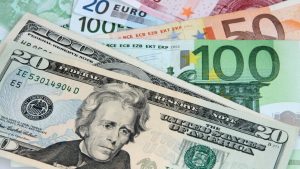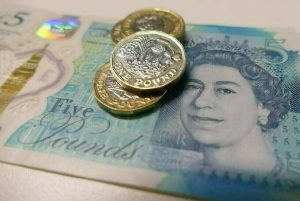DOLLAR EASES VS EURO AFTER GERMAN VOTE ON A SPENDING SURGE
The dollar eased against the euro on Tuesday as Germany’s parliament approved plans for a massive spending surge on Tuesday and as the Federal Reserve kicked off its March policy meeting that could offer clues to the path of U.S. interest rates. The euro was 0.2% higher at $1.0945, after hitting $1.0954 earlier in the session, its highest since October 10. “Germany, and by extension the euro zone, getting their fiscal act together is not only long overdue, but supports the bull case for the common currency over the medium-term,” Michael Brown, senior research strategist at Pepperstone, said. The euro also found support earlier after data showed German investor morale improved more than expected in March. More broadly, currency market moves were largely muted on Tuesday as investors awaited policy announcements from major central banks, including from the Federal Reserve on Wednesday. While analysts expect the Fed to hold its monetary policy stance amid persistent inflation concerns, investors will be looking to new economic projections from Fed officials for evidence of how U.S. central bankers view the likely impact of Trump administration policies. “The SEP (Summary of Economic Projections) will be the most interesting aspect, I imagine, with near-term inflation expectations likely nudged higher, and growth projections marked down a touch, though conviction behind those forecasts is going to be lacking, amid the ever-changing macro outlook,” Brown said. The greenback hit a two-week high against the yen before paring gains to trade about unchanged on the day at 149.165 yen, ahead of Wednesday’s policy decision by the Bank of Japan. BOJ policymakers are expected to discuss just how much of a risk the escalating U.S. trade war poses to Japan’s economy. “We would expect this adjustment in the pricing of the terminal rate to be maintained following the BoJ meeting,” said Lee Hardman, senior currency analyst at MUFG, referring to market expectations that rose from around 0.90% at the end of 2024 to close to 1.20%. Elsewhere, the Australian dollar slipped 0.4% to $0.6358 after rising to its highest in about a month on Monday. Bitcoin , the world’s largest cryptocurrency by market cap, was down 2.5% at $81,922.

DOLLAR RISES AS FED SEES NO RUSH TO CUT RATES
The dollar appreciated broadly on Thursday, a day after the Federal Reserve indicated it was in no rush to cut interest rates further this year due to uncertainties around U.S. tariffs. The Swiss franc weakened after the Swiss National Bank lowered its policy rate to 0.25%, while the Swedish krona was soft after its central bank maintained its interest rate. The euro was 0.46% lower against the dollar at $1.0852 after U.S. policymakers, on Wednesday, held interest rates steady and signaled two quarter-point interest rate cuts for later this year, the same median forecast as three months ago. We’re not going to be in any hurry to move,” Fed Chair Jerome Powell said. Powell’s comments and the Fed statement underscored the challenge faced by policymakers as they navigate President Donald Trump‘s plans to levy duties on imports from U.S. trading partners and the impact on the economy. Data on Thursday showed the number of Americans filing new applications for unemployment benefits increased slightly last week, suggesting the labor market remained stable in March. Recent U.S. data have helped temper worries over slowing U.S. growth that prompted the dollar to sag as much as 7% against the euro since mid-January, Jayati Bharadwaj, a global FX strategist at TD Securities, said. “A lot of the bad news was already priced in, but none of the hard data is collapsing the way markets were fearing it would, and even the Fed is not indicating to you that they’re in a hurry to ease rates again,” she said. “All of that is leading markets to reassess some of the bearishness that they have been pricing into the dollar,” Bharadwaj, who expects the dollar to strengthen in the near term, said. Traders are pricing in about 63 basis points of Fed easing this year, LSEG data showed. With President Donald Trump still expected to implement new reciprocal tariff rates against major trading partners on April 2, investors were skittish about pressing bearish bets on the dollar.
FG PLANS TO RAISE N300BN VIA MARCH BOND AUCTION
The dollar edged up against the euro on Friday, on pace for its first weekly gain this month, as investors booked profits from the euro’s recent advance ahead of the April 2 deadline for reciprocal U.S. tariffs. The euro was 0.3% lower at $1.08223, on pace to finish the week down 0.6%, its first weekly loss since February 28. The dollar, under pressure this year from worries over the hit to U.S. economic growth from the Trump administration’s trade policies, found some respite this week as the Federal Reserve indicated it was in no rush to cut interest rates. The euro softened as investors booked gains, even as Germany’s Bundesrat, the upper house of parliament, passed a reform of the country’s borrowing rules and a 500-billion-euro fund to revamp its infrastructure and revive Europe’s largest economy. “It’s really been a huge rally in EUR/USD this quarter … so, naturally, we’re seeing some profit-taking ahead of the April 2 tariff deadline,” said George Vessey, lead FX and macro strategist at Convera. “Given the lack of reaction to the German Bundestag’s approval of the debt break constitutional change this week, perhaps we’re near peak optimism regarding the fiscal tailwind,” he added. This week the Fed, Bank of England and Bank of Japan left interest rates unchanged as they assessed the economic impact of U.S. President Donald Trump’s trade tariffs against global trading partners. Fed policymakers signaled two quarter-point cuts later this year, the same median forecast as three months ago. “We’re not going to be in any hurry to move,” Fed Chair Jerome Powell said, underscoring the challenge policymakers face in navigating Trump’s tariffs policy, and the potential impact on the domestic economy. It remains an open question for the Fed whether tariff plans will lead to persistent inflation, with taxes on intermediate goods, retaliation by other nations, and other factors feeding into whether the central bank will have to respond, Chicago Fed President Austan Goolsbee said on Friday.
CANADIAN DOLLAR CLINGS TO THIRD STRAIGHT WEEKLY GAIN
The Canadian dollar edged lower against its U.S. counterpart on Friday as domestic data showed retail sales declining in the first two months of 2025 and tariff uncertainty lingered, but the currency was holding on to a modest weekly gain. The loonie was trading 0.1% lower at 1.4340 per U.S. dollar, or 69.74 U.S. cents, after trading in a range of 1.4314 to 1.4373. For the week, the currency was up 0.2%, which would be its third straight weekly gain. The Canadian dollar is likely to continue trading in a somewhat flat range for now “as markets await clarity” on proposed U.S. tariffs, Shaun Osborne, chief currency strategist at Scotiabank, said in a note. Wall Street clawed back some of its declines after U.S. President Donald Trump hinted there would be some flexibility regarding tariffs. Trump has promised tariffs on autos beginning April 2, alongside a more sweeping agenda of reciprocal tariffs. Earlier this month, he suspended until April 2 tariffs of 25% he had imposed on most goods from Canada. “In terms of the implications for Canada, misery loves company,” Avery Shenfeld, chief economist at CIBC Capital Markets, said in a note. “Both the impacts on our exports to the US, as well as our odds of negotiating these tariffs down to a manageable size, would be improved by having many other US trading partners in the same boat.” Canadian retail sales shrank 0.6% month-over-month in January after December’s purchases were bumped up by a sales tax break which ended in the middle of last month. A preliminary estimate for February showed sales down 0.4%. The Canadian 10-year yield was trading nearly unchanged at 3.016%, while it was trading 1.3 basis points further above the 2-year yield at a spread of 49.6 basis points, its widest since February 2022.

STERLING EDGES DOWN BUT SET FOR ANOTHER WEEKLY GAIN AFTER BOE MEETING
The British pound extended its decline against the dollar on Friday but was poised to end the week higher, a day after the Bank of England kept interest rates unchanged and raised concerns about a rise in global trade tensions. Sterling was down 0.2% at $1.29405 after hitting as high as $1.301 earlier this week. It was on track for its third-consecutive week of gains. Against the euro, the British currency was little changed at 83.695 pence to the common currency. On Thursday, BoE governor Andrew Bailey, echoing other central bankers around the world, highlighted the sudden lack of visibility about the outlook due largely to U.S. President Donald Trump’s tariffs against global trading partners. “There’s just a general sense of caution. We don’t really know what are the implications of the trade war on growth and inflation,” said Kenneth Broux, head of corporate research FX and rates at Societe Generale. Even though Britain has so far escaped most of the tariff rhetoric from Trump, the next round of U.S. reciprocal tariffs in early April and their potential implications and spillover to the UK economy remain to be seen, Broux said. Upcoming UK inflation and wage growth data are the key things to watch, Broux said. The UK economy is also at risk of rising inflation as a tax hike for employers kicks in next month. The BoE predicted a peak in British inflation of 3.75% in the third quarter of this year, up slightly from a February estimate of 3.7%. It nudged up its estimate for economic growth in the first three months of 2025 to 0.25% from 0.1%. Meanwhile, data on Friday showed that Britain borrowed a lot more than expected last month, underlining the scale of the challenge facing finance minister Rachel Reeves, who is expected to announce cuts to her spending plans next week.

- CAPITALDIGEST MARKET REVIEW , 03/11/2025November 3, 2025
- CAPITALDIGEST DAILY NEWS, 03/11/2025November 3, 2025
- CAPITALDIGEST MARKET REVIEW, 22/09/2025September 22, 2025
Enter your email address for receiving valuable newsletters.
- CAPITALDIGEST DAILY NEWS, 03/11/2025NNPCL WEIGHS OVERHAUL, REPURPOSING OPTIONS FOR REFINERIES The Nigerian National Petroleum Company Limited has said...November 3, 2025
- CAPITALDIGEST MARKET REVIEW, 22/09/2025STERLING RISES AGAINST DOLLAR ON FED-BOE POLICY DIVERGENCE Sterling gained against the dollar on Tuesday,...September 22, 2025
- CAPITALDIGEST DAILY NEWS, 22/09/2025OIL REFORMS DRIVE $18.2BN DEALS – FG Nigeria’s oil and gas sector is experiencing a...September 22, 2025












